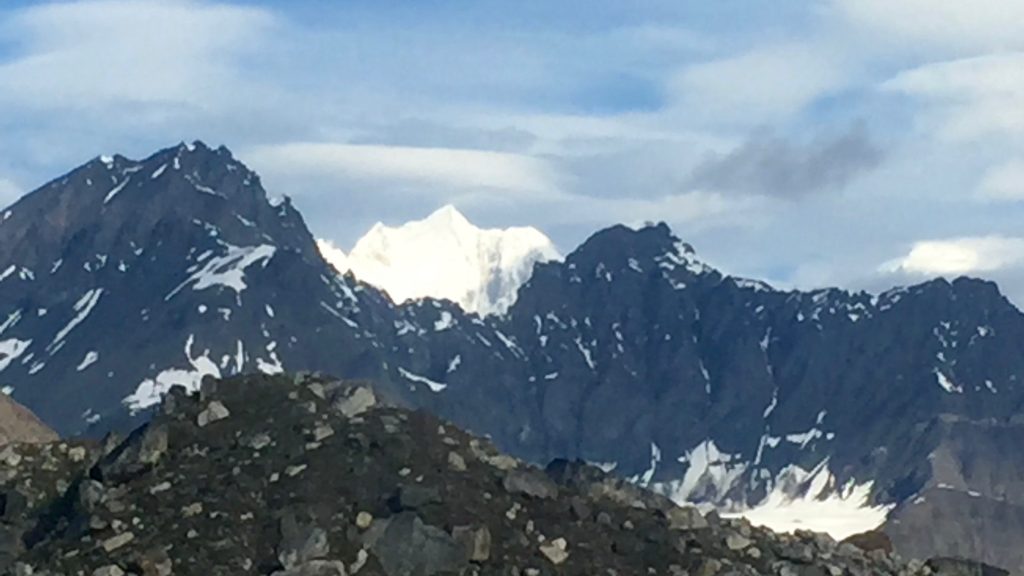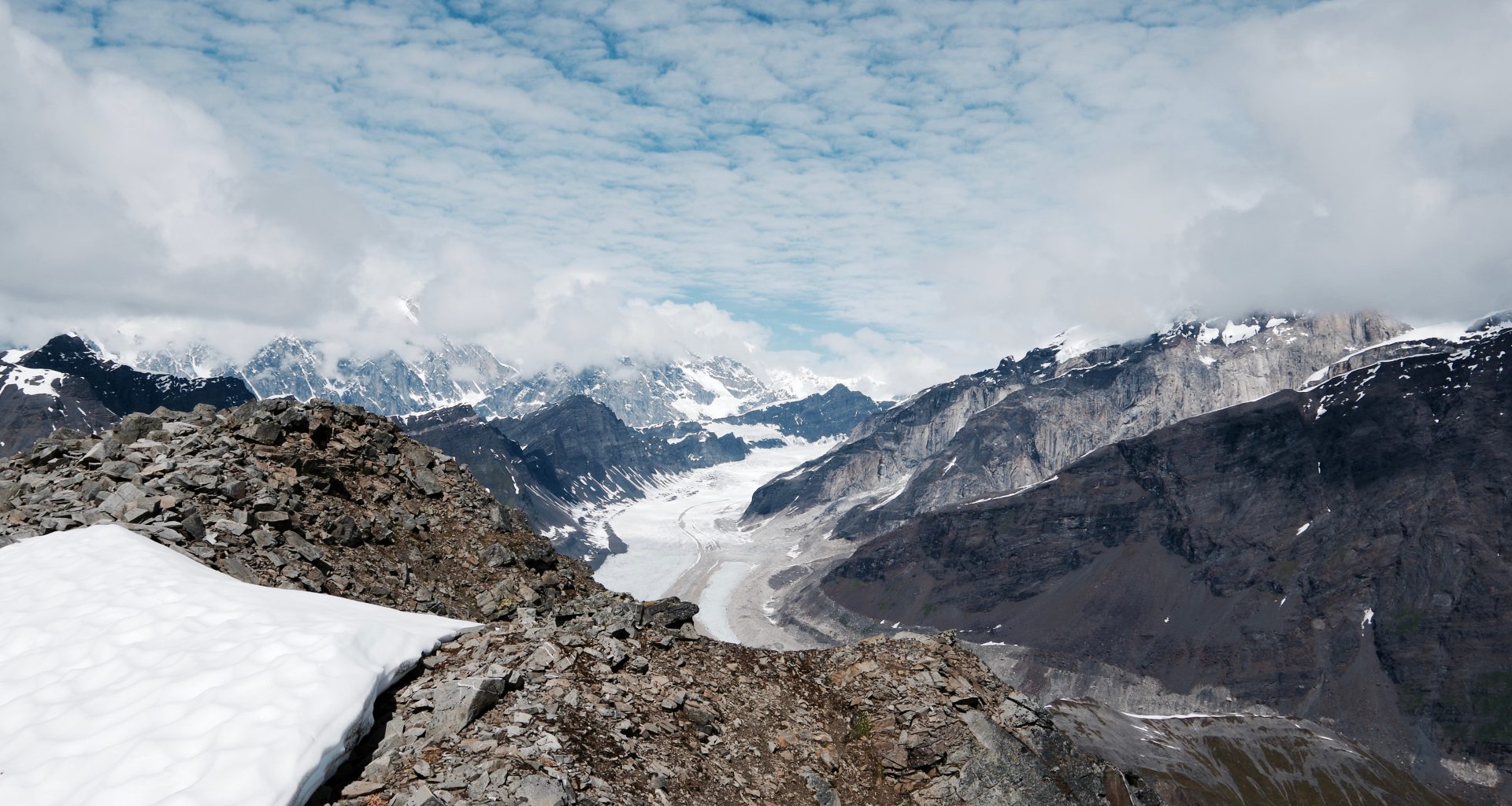An Unexpected Moment of Zen in the Alaska Range
“People come here hoping to have some kind of spiritual experience. The mountains are just here, they have nothing to give you.” My trekking guide was a brutal realist. He had been here to the backside of Denali many times and was beyond being precious about the experience. We had been ferried in by bush plane that morning to a small glacial lake on the backside of Denali. The lake sat between the mouth of Backside Glacier and the gargantuan 4000-foot deep and 35 mile long, Ruth Glacier. This was the wild side of Denali, filled with jagged peaks, hanging glaciers, soaring ice falls, and glacial moulins you could fly a small plane into. My brain could barely process what I was seeing.
After setting up camp, we took an evening walk to a small hanging lake perched above Ruth Glacier. It was the middle of summer, warm, and the sun wouldn’t set until after midnight. Denali’s peak, 15 miles to the north, was covered in clouds while the surrounding mountains enjoyed clear skies. According to my guide, Denali is such a large massif that it creates its own weather system. It eluded our view the entire four days we spent trekking around Backside Glacier. It became a running joke among my fellow trekkers: “Is that Denali? Is that Denali? Which Way to Denali?” we asked, pointing at the many unnamed peaks that make up the Alaska Range. The moment reminded me of one of my favorite Zen Koans.
Jōshū and the Old Woman
A monk asked an old woman, “What is the way to Taisan?” The old woman said, “Go straight on.” When the monk had proceeded a few steps, she said, “A good, respectable monk, but he too goes that way.” Afterward someone told Jōshū about this. Jōshū said, “Wait a bit, I will go and investigate the old woman for you.” The next day he went and asked the same question, and the old woman gave the same answer. On returning, Jōshū said to his disciples, “I have investigated the old woman of Taisan for you.”
Taisan, sometimes called Tai or Tai Shan, refers to a sacred mountain in Buddhism. It is also sometimes referred to in Buddhist texts as Mount Sumeru, or Meru. Taisan is considered the center of the universe and a symbol of enlightenment. The way to Mount Taisan, like Denali, should be obvious to anyone in its shadow, yet we still seek guidance.
In Soto Zen, the concept of enlightenment, like the soaring peak of Taisan, is always right in front of us. It surrounds us no matter which direction we look. The old woman in the koan might be responding to Joshu a little cynically. She had probably been asked this question many times by pilgrims seeking confirmation of the obvious on their path to enlightenment.
My guide was showing off a bit of his own buddha-nature when he told me not to expect anything special from these mountains. It was a good reminder. The mountains, the immense glaciers, and my two feet walking over the rugged moraine were already one. My heart felt full. The koan and life had mysteriously converged.
This moment of kyōgai, or shift in consciousness, at the foot of Denali reminded me of another I had experienced many years before. In the 2000 movie “The Beach”, Leonardo DiCaprio’s character, a young traveler named Richard, arrives in Bangkok and learns about a secret utopian island community somewhere off the coast of Thailand. Eventually he finds the island, but his utopian dream quickly turns into a nightmare. At the end of the movie, Richard narrates the closing credits:
“And me, I still believe in paradise. But now at least I know it’s not some place you can look for, because it’s not where you go. It’s how you feel for a moment in your life when you’re a part of something, and if you find that moment… it lasts forever…“
From the Movie ‘The beach’
I’ve always kept his words in mind as I’ve traveled the world. Exploring new places is a wonderful thing, but the destinations do not bring happiness and fulfillment. A little more contentment is possible, but the old saying “Life is all about the journey, not the destination” rings truer with each new place that you go. When we put unrealistic expectations on the external world, other people, or ourselves, we are bound to be disappointed. When we accept things as they are and let go of the need to control or gain something from them, then we discover our own version of Richard’s inner paradise.
The Lone Wolf
While the clouds around Denali remained unwilling to part, from my tent I could see the peak of Begguya, or “Denali’s Child”. Its glacier-covered summit stood above two unnamed peaks in the foreground. Also known as Mount Hunter, it is one of the most difficult climbs in the Alaska range–considered even more difficult than Denali. While a full vertical mile shorter than Denali, its steep, rugged face and icy cornices make it a more technical and dangerous climb.

Mount Hunter, Alaska Range
I had brought the book “In the Shadow of Denali”, by Jonathan Waterman, along for the trek. In the book, Waterman chronicles his and other famous climbers’ adventures summiting the peaks around the Alaska Range in the 1970s and 80s. In the chapter titled “The Lone Wolf”, he recounts the exploits of one of Alaska’s most legendary climbers, his namesake, Johnny Waterman. Johnny’s most famous climb was a 145-day solo of the unclimbed southeast spur of Mount Hunter.
A furious and fearless climber, Johnny took greater and greater risks as his young climbing career progressed. At age 26, his solo ascent and traverse of Mount Hunter in March of 1978 was viewed by other climbers as both masterful and insane. To survive for the nearly five months of his solo expedition, Johnny’s small but strong frame had to ferry over 600 pounds of supplies and gear up Hunter’s treacherous face. Moving all this gear to each of the twelve camps on his chosen route required twelve round trips for each section. This meant he would essentially climb and descend the mountain a dozen times during the expedition. On his way up, he survived numerous near-deadly falls, weeks-long snowstorms, and even a bad case of body lice. Johnny called the climb a “vendetta”, having failed to summit Hunter on two previous attempts. It’s a solo feat which has never been repeated.
Johnny’s unquenchable desire to conquer the hardest climbing routes in the Alaska Range culminated with a fateful attempt to summit Denali via its unclimbed east face. At that point, some three years after his successful solo climb of Hunter, Johnny had experienced great loss. Most of his climbing friends had perished, either in climbing accidents or avalanches. His brother Bill, who lived with him in Alaska for a time, disappeared without explanation and was never heard from again. Johnny’s cabin in Talkeetna burned down, taking with it all of his climbing diaries and writings. While Johnny was always a bit of a social misfit in the real world, after the cabin fire his acquaintances thought he had become a shell of his former self. The mountains were all he had left.
Before the question is asked,
Loori Roshi, Capping Verse, The Woman of Daishan. The True Dharma’s Eye
you have already arrived.
Before taking a step,
you are already home.
From our camp at Backside glacier, I looked up at Hunter and thought of Johnny ferrying his gear up the mountain. He conquered the mountain, but his inner demons remained. The draw of the Alaskan peaks offered only a temporary reprieve from the loneliness and disconnectedness he felt in the real world. Like my guide said at the beginning of the trip, the mountains had nothing to offer Johnny, they were just there. Sadly, Johnny would never discover this. His attempt to climb the east face of Denali would be his last. His long romance with the mountains ended somewhere high up on Ruth Glacier, near the ice falls of Denali. Johnny’s gear was found on Ruth, emblazoned with the words “The Last Kiss”3. It was a poetic, yet tragic death.
Gazing up the mile-wide Ruth Glacier, I imagined Johnny’s ghost making his approach to Denali–dancing across a sea of deep crevasses in a kind of climber’s ballet. His visage was a powerful reminder that the more we seek fulfillment, the more elusive it can become. It is a pursuit with no reward. I hoped he was free. Had Johnny been able to see that the fulfillment and inner peace he sought were already present in him, he might not have needed to push the physical boundaries of his being to such a tragic end. This kind of personal enlightenment isn’t a destination; it is already in every journey we take, everyone we encounter, and everything we experience. “Because it’s not where you go. It’s how you feel for a moment in your life when you’re a part of something, and if you find that moment… it lasts forever…”
- Mumonkan. Two Zen Classics (p. 100). Shambhala.
- Loori, John Daido. The True Dharma Eye (p. 182). Shambhala.
- Waterman, Jonathan. In the Shadow of Denali: Life And Death On Alaska’s Mt. Mckinley . Lyons Press.








